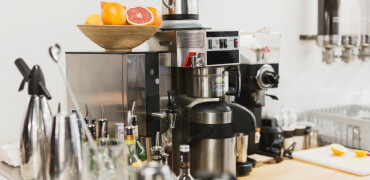A home-cooked meal comes along with quite a few different repetitive processes that take time and can which are tedious. Anytime you need to chop, mince, puree, slice, shred, or grind, you could spend more time doing these things than actually cooking a meal. The whole purpose of the food processor is to handle these situations specifically.
Essentially, this appliance will usually include interchangeable blades, a bowl to catch the food, and a motor that forces the blades to chop or process the food in another way. Because food processors are relatively new on the appliance scene, many households simply don't have them. However, they can be extremely useful in many situations.
For example, if you spend a great deal of time making home-style meals, you will likely have to chop, grind, or shred a number of different ingredients. A food processor will only take seconds to complete a task that could take you long, tedious minutes.
The Difference Between Food Processors and Blenders
Some people think that they can simply purchase a blender to work as a catch-all for many different processes. However, this simply won't work. Because the blender has blades at the bottom of a conical bowl or receptacle, it will only work well if some of the ingredients are liquid. A food processor has wide, sweeping blades in a cylinder-shaped receptacle. You don't have to use liquids allowing you to chop, shred, or grind dry ingredients.
What to Look for
When you start shopping for food processors, you will find that there are numerous different models and types that you could choose. You certainly want to purchase a piece of equipment that will actually be used and won't just end up in a cabinet. That means looking for the right things when you decide to purchase.
Make sure the processor is powerful so that it can handle any ingredients.
Look for a model that is heavier so that it won't skitter across the counter when in use.
Think about capacity. You need enough room, so consider purchasing a processor that can hold up to nine cups unless space in your kitchen requires a smaller model.
Take a look at controls. Of course, you need to be able to operate the food processor, so choose a model that you are comfortable with.
Consider safety features like locking bowls and other mechanisms. This is especially important if you have children in the house.
Look at the tube size of the food processor, especially if you will be chopping or grinding large types of foods.
All of these features are considered standard depending on the type of model you choose. You certainly don't have to pick a food processor with all of the features, but you do need to evaluate what will be important for you in the kitchen.
Optional Features
Many food processors will also include optional features that could make your cooking life much easier. The more options that the appliance includes, the higher price you can expect to pay, however. Before you go shopping, consider the features that might matter to you:
- Extra blades or attachments for more functionality.
- A mini chopper that will use a smaller bowl ideal for chopping herbs and spices.
- A continuous feed mechanism that will allow you to send processed food directly onto a plate or bowl so that you don't have to keep emptying the receptacle.
- Touch pad controls are found on more modern devices. They will allow you to specifically set speed, power, and chop style and they may be easier to use if you have been working with your hands in food all day.
- Instructions and DVD programs. If you have trouble learning how to use new appliances, then you may wish to look for food processors that come with instructional DVDs. These videos will help you learn how to use basic controls as well as more advanced options on the processor.
Price Expectations
The brand of food processor that you choose can change quite a few different things, including features and price. A food processor is an advanced appliance for your kitchen, so you do need to be prepared to pay more for the device.
You can find processors for less than $100, but if features are important to you, then you can expect to pay close to $1,000. The vast majority of food processors will use electronic mechanisms and a motor to run the blades. However, if you are most interested in saving money, hand-run styles are available. They will be very limited in what they will be able to accomplish and will still require a great deal of manual labour. Of course, there's always the option to repair your old food processor if you have one by buying food processor parts online.
There are many different brands of food processors that you can choose from and they will each come along with varying features, extras, and capacities. You may need to compare some of the top brands, like Kenwood, Magimix, Cuisinart, and Braun to determine which models will include the features most important to you. Remember that choosing from the top models will open up the door for more advanced features, allowing you to do more with your food processor.




